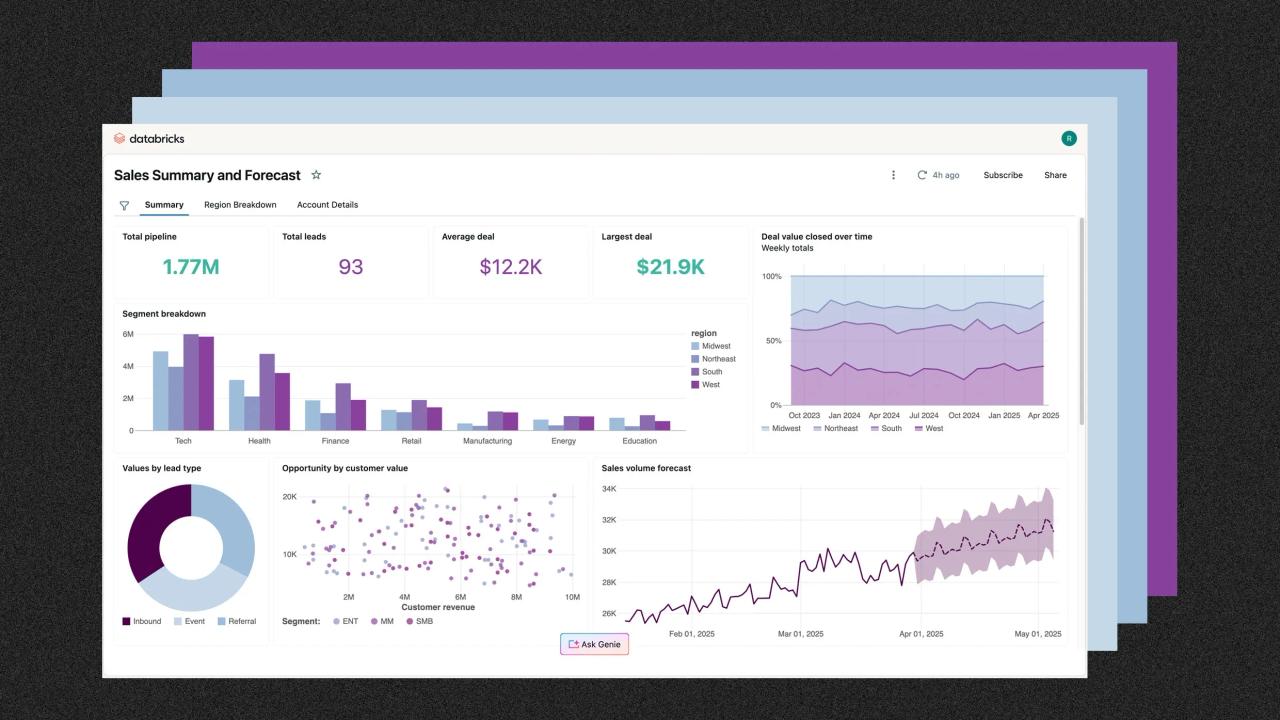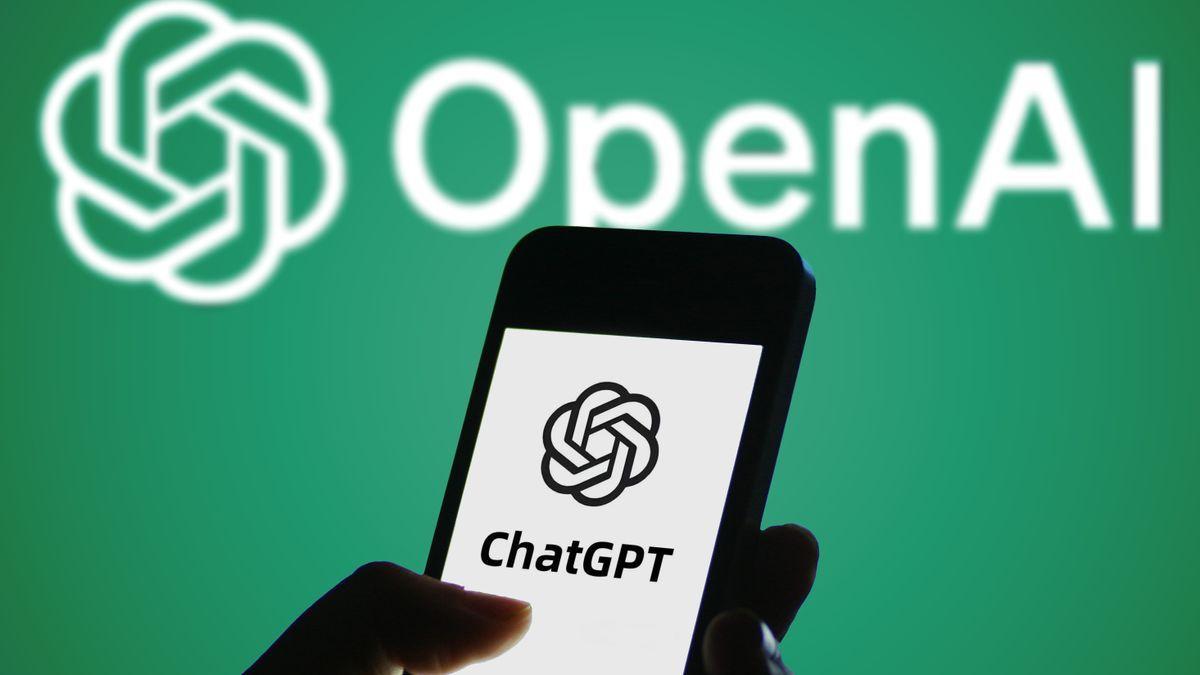Databricks Unveils 'One' Dashboard: Democratizing AI for Business Users
3 Sources
3 Sources
[1]
Databricks' new 'One' dashboard brings AI to the business class (exclusive)
Until now, access to the Databricks platform was primarily limited to engineers and data scientists with SQL or Python skills. Databricks One introduces a completely redesigned interface, simplified specifically for users without a technical background. "We want to make our experience for nontechnical users as amazing as our experience for technical users," said Databricks cofounder and CEO Ali Ghodsi. "This is our first step of making this true so that everyone across the organization can unlock the full value of their data and drive innovation." The Databricks One tool resembles an AI chatbot interface. Users can describe the type of data or analysis they need, and a large language model translates those requests into actions. According to Ghodsi, this could involve deploying AI agents that tap into pipelines of various models and databases to retrieve data or perform specific analyses.
[2]
Databricks brings data insights to every business worker with AI-powered BI - SiliconANGLE
Databricks brings data insights to every business worker with AI-powered BI Databricks Inc. says it's trying to bring the power of big data analytics to every business worker with the launch of its new artificial intelligence-powered business intelligence tool, Databricks One. The company sells a cloud-based data warehouse platform that provides a collaborative environment for data engineering, data science, machine learning and analytics. It has become especially popular with companies who need to harness the power of their data for artificial intelligence. But until now, it has always been limited to engineers and data scientists who possess the requisite Python and Structured Query Language skills. Databricks One changes that, introducing a simplified user interface that makes the platform's capabilities accessible to every kind of business worker. "Our mission at Databricks is to democratize data and AI," said Databricks co-founder and Chief Executive Ali Ghodsi. "Every person of every skill level should have equal access to work with data and use AI. With Databricks One, we want to make our experience for non-technical users as amazing as our experience for technical users." The company announced Databricks One today at its annual Data + AI Summit today in San Francisco, saying it is available now in private preview ahead of a private beta slated for later in the summer. While it's currently free to use, the company intends to implement a metered pricing model based on token consumption by AI models and usage time. It'll do that because the entire platform is powered by generative AI models. The interface looks much like ChatGPT and other generative AI assistants, and allows users to describe the type of data analysis they want to perform. Then, a large language model performs the necessary technical work to get that analysis done. It can do things like deploying AI agents into data pipelines and databases to perform extremely specific and detailed analysis, the company said. Before Databricks One, users would need coding skills to be able to make these kinds of requests, but the LLM eliminates the need for that. It generates the required SQL code itself, and executes it on the customer's data warehouse, abstracting the complexity away from the user. Once the analysis is done, Databricks One will show the results via suitable visualizations that appear directly in its interface. Users can then dig into these visualizations with an "AI/BI Genie", and ask more detailed questions using natural language. The use cases are varied. For instance, a marketing professional might want to perform some analytics to see how effective their latest campaign has been, while a legal professional might want to review any overlapping business contracts that might conflict with one another. Else, a salesperson could use it to gather every piece of information they need ahead of a meeting with a new lead. In an interview with Fast Company, Ghodsi said customers have been asking for years for these kinds of AI-powered business intelligence capabilities. They want their regular business workers to be able to perform the same deep analytics that their engineers already do, because it would allow them to act on the insights they dig up much faster. However, many customers - especially those in regulated industries such as finance and healthcare - also highlighted concerns about data security and the prospect that business workers might misinterpret the findings from their data. This is why it took so long for Databricks to build the Databricks One platform, Ghodsi said. The company spent more than two years designing guardrails to ensure the security of customer data. These guardrails make sure the most sensitive data is sandboxed, and users can be restricted to read-only access, he said. Databricks One was launched on a hectic day for the company, which also debuted a new agentic AI platform called Mosaic Agent Bricks. It provides tools for automating AI agent building and customizing them using customer's private data and synthetic information based on those archives. In addition, the company announced a new serverless database called Lakebase, which is based on the popular open-source relational database software PostgreSQL and can process more than 10,000 queries per second to power demanding AI workloads. Today's updates illustrate Databricks' determination to capitalize on the demand for AI applications and become the main provider of the data that powers them. Investors have backed the company heavily, with venture capitalists putting more than $14 billion into its war chest, boosting its value to an astonishing $62 billion as of December 2024.
[3]
Databricks Targets Business Users With Databricks One, Lakeflow Designer Offerings
Databricks, which has traditionally appealed to coding-savvy data scientists and data engineers, is making a play to broaden its base of users with new products unveiled this week at the company's Data + AI Summit. Databricks has long served data development teams, including hard-core data engineers and data scientists, with its flagship Data Intelligence Platform and its myriad data management capabilities. But Databricks, at its Data + AI Summit in San Francisco this week, is making a bid to provide data management and analysis tools that will allow nontechnical business analysts and business users to make more productive use of the company's platform. On stage Thursday, company executives demonstrated Databricks One, a new front-end interface that will provide business users with easier access to a number of Databricks data and AI capabilities, including AI/BI dashboards and the Genie natural language data query tool, as well as access to applications built using Databricks Apps development tools. [Related: Databricks Looks To Disrupt Legacy Database Space With New 'Lakebase' Offering] They also demonstrated Lakeflow Designer, a no-code tool that data analysts can use to easily build reliable data pipelines without the assistance of data engineers. Both products were officially unveiled Wednesday but were introduced and demonstrated on stage Thursday. "Databricks One is a brand-new Databricks experience designed for business users," Ken Wong, Databricks senior director of product management, said during the keynote presentation. "We want it to be the one place they go to get data and AI." "This is a complete reimaging of what Databricks can be for business users in your organization," said Miranda Luna, Databricks director of product management, while demonstrating Databricks One's capabilities. Along with business users and business analysts, Databricks One -- currently in private preview -- also targets executive teams in finance, sales and marketing. A key component of Databricks One is AI/BI Dashboards that allow business users to perform advanced analytics, such as forecasting and key driver analysis, and generate visualizations of analytical results. Databricks One also features AI/BI Genie, a conversational assistant that Databricks says provides deep, contextual insight on demand by allowing users to ask questions in plain language and get instant, accurate visual answers backed by data. Databricks One also provides business users with secure access to Databricks Apps, the company's development capabilities for natively building and deploying data-intensive analytical and AI applications directly on the Databricks Data Intelligence Platform. Databricks Apps, launched in October 2024, provides a way to package up complex workflows that combine analytics, AI and transactional processing within custom applications for specific use cases. "Our mission at Databricks is to democratize data + AI," said Ali Ghodsi, Databricks co-founder and CEO, in the Databricks One announcement. "Every person of every skill level should have equal access to work with data and use AI. With Databricks One, we want to make our experience for nontechnical users as amazing as our experience for technical users. This is our first step of making this true so that everyone across the organization can unlock the full value of their data and drive innovation." Data + AI attendees applauded loudly when Databricks managers demonstrated Lakeflow Designer during the keynote. The new software provides nontechnical data analysts with a no-code data ETL (extract, transform and load) approach to building reliable, production-grade data pipelines, according to Databricks. Data pipelines are traditionally built by data engineering teams. But with such projects often facing backlogs, data analysts sometimes take on the job themselves using low-code/no-code tools that Databricks says can sacrifice data governance, and system reliability and scalability. Lakeflow Designer, which will be in preview mode later this summer, uses a visual drag-and-drop user interface and a natural language generative AI assistant to create data pipelines with the same scalability, governance and maintainability as pipelines built by code-first data engineers using more sophisticated tools, according to Databricks. While targeted toward nontechnical users, Lakeflow Designer is backed by Databricks Lakeflow, the company's data pipeline development platform for technical data engineering teams that was unveiled in June 2024. This week Databricks announced that Lakeflow is now generally available. At the Data + AI Summit, Databricks also introduced Lakebridge, a free, AI-powered data migration tool to help customers move off legacy data warehouse systems to Databricks SQL, the company's data analytics software within the Databricks Lakehouse platform. Lakebridge is based on technology Databricks acquired in February when it bought BladeBridge, a developer of AI-powered enterprise data warehouse migration software. Databricks said Lakebridge can automate up to 80 percent of a migration project, including data profiling, SQL conversion, validation and reconciliation tasks. Meanwhile, Databricks and Google Cloud unveiled a strategic AI partnership through which Google Cloud's Gemini models will run natively on the Databricks Data Intelligence Platform. And Databricks and Microsoft unveiled a multiyear extension of their strategic partnership that covers Azure Databricks, a joint offering from the two companies that integrates Databricks' data, analytics and AI capabilities into the Azure cloud ecosystem with connectivity to Microsoft's Power BI, Azure OpenAI and Microsoft Purview.
Share
Share
Copy Link
Databricks launches 'One' dashboard, an AI-powered interface that makes data analytics accessible to non-technical business users, marking a significant shift in the company's strategy to democratize AI and data insights.
Databricks Introduces 'One' Dashboard for Business Users
Databricks, a leading provider of cloud-based data warehousing and analytics solutions, has unveiled its latest innovation: Databricks One. This new AI-powered dashboard is designed to bring the power of data analytics and artificial intelligence to non-technical business users, marking a significant shift in the company's strategy
1
.Democratizing Data and AI
Databricks One introduces a completely redesigned interface, specifically simplified for users without a technical background. This move aligns with the company's mission to democratize data and AI, as stated by Databricks co-founder and CEO Ali Ghodsi: "Every person of every skill level should have equal access to work with data and use AI"
2
.
Source: SiliconANGLE
AI-Powered Interface
The new tool resembles an AI chatbot interface, allowing users to describe the type of data or analysis they need in natural language. A large language model then translates these requests into actions, potentially deploying AI agents that tap into various models and databases to retrieve data or perform specific analyses
1
.Key Features of Databricks One
- AI/BI Dashboards: These allow business users to perform advanced analytics, such as forecasting and key driver analysis, and generate visualizations of analytical results
3
.

Source: Fast Company
-
AI/BI Genie: A conversational assistant that provides deep, contextual insight on demand by allowing users to ask questions in plain language and get instant, accurate visual answers backed by data
3
. -
Access to Databricks Apps: Provides business users with secure access to Databricks' development capabilities for building and deploying data-intensive analytical and AI applications
3
.
Expanding User Base and Use Cases
Databricks One targets a wide range of non-technical users, including marketing professionals, legal professionals, and salespeople. For instance, a marketing professional could use the tool to analyze the effectiveness of their latest campaign, while a salesperson could gather comprehensive information before meeting with a new lead
2
.Related Stories
Security and Pricing
Recognizing concerns about data security, especially in regulated industries, Databricks spent over two years designing guardrails to ensure the security of customer data. These measures include sandboxing sensitive data and providing read-only access to certain users
2
.Databricks One is currently available in private preview, with a private beta planned for later in the summer. While it's currently free to use, the company intends to implement a metered pricing model based on token consumption by AI models and usage time
2
.Additional Announcements
Alongside Databricks One, the company also introduced Lakeflow Designer, a no-code tool for building data pipelines, and Lakebase, a new serverless database based on PostgreSQL. These additions further demonstrate Databricks' commitment to expanding its offerings and capitalizing on the growing demand for AI applications
3
.References
Summarized by
Navi
[2]
Related Stories
Databricks Launches 'Apps' for Rapid Development of AI and Data Applications
09 Oct 2024•Technology

Databricks Launches Serverless Lakebase Database, Challenging Legacy Database Market
12 Jun 2025•Technology

Databricks Unveils New Tools for Scalable and Governed AI Agents in Enterprise Applications
12 Mar 2025•Technology








